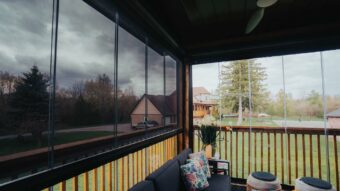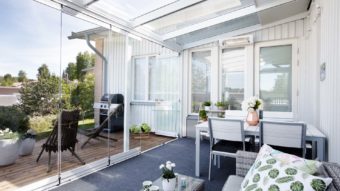
What is the Right Foundation for a 3-Season Sunroom?: Pros and Cons
Building a 3-season sunroom is an exciting venture that can add both beauty and value to your home. However, one of the most critical aspects of sunroom construction is choosing the right foundation. The foundation is critical to the sunroom’s stability, comfort, and longevity. It serves as a stable base, supporting the weight of walls, windows, doors, and any furniture or appliances you might place in your sunroom.
If you’re wondering for information on if you’re able to build a 3-season sunroom on an existing deck, you can read our blog on that here.
In this article, we will explore different foundation types for a 3-season sunroom, weighing their pros and cons and outlining key considerations to help you make an informed decision if you’re starting from scratch.
Understanding 3-Season Sunroom Foundations
A 3-season sunroom is designed for use in spring, summer, and fall. Unlike four-season sunrooms, they aren’t typically insulated for winter use, making the choice of foundation slightly different. The foundation you choose will affect not only the stability and longevity of the sunroom but also its comfort and usability.
The foundation is a critical component of your sunroom. Selecting the right foundation ensures that your sunroom remains durable and functional for years to come.
Types of Foundations for 3-Season Sunrooms
When it comes to sunroom installation, there are several foundation options to consider. Each type offers unique benefits and drawbacks.
Wooden Decks
Wooden decks are a practical and cost-effective foundation option for sunrooms. However, to ensure structural integrity and compliance, certain specifications must be followed.
Key Requirements:
- The foundation must meet Ontario Building Code (OBC) standards.
- Deck should be supported by sonotubes or helical piles for stability and frost heave protection.
- Support needed under the sunroom posts – so work with a sunroom supplier before construction starts.
Pros of Wooden Decks
- Cost-Effective: Typically, less expensive than concrete foundations.
- Versatility: Can be built to suit uneven terrains.
Cons of Wooden Decks:
- Requires Engineering: Additional planning and professional oversight needed for structural compliance.
- Maintenance: Wood may require regular maintenance to prevent rot or pest issues.
Best For:
- Homeowners that look the wooden/composite look
- Homeowners looking for an affordable, adaptable foundation solution that meets building code requirements.
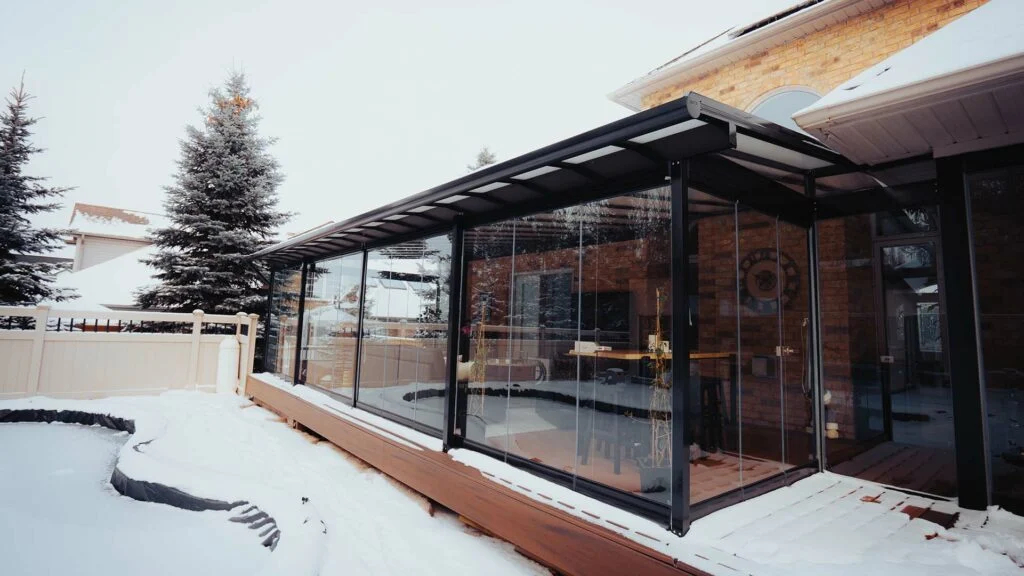
Concrete Pads with Foundation Wall
Concrete pads with a foundation wall offer unmatched stability and durability, making them a premium choice for sunrooms in colder climates.
Key Requirements:
- Perimeter Walls: A concrete foundation wall is required along all perimeter walls to prevent frost heave and support the load.
- Interior Surface: The sunroom’s interior should feature a min. 4” thick concrete pad.
Pros of Concrete Pads with Foundation Walls:
- Frost Heave Prevention: Good for areas with freezing temperatures.
- Load-Bearing: Provides a strong base for larger or heavier sunrooms.
- Low Maintenance: Requires minimal upkeep once installed.
Cons of Concrete Pads with Foundation Walls:
- Higher Cost: More expensive than other foundation types due to materials and labor.
- Permanence: Difficult to modify once installed.
Best For:
- Homeowners prioritizing a durable, long-term solution.
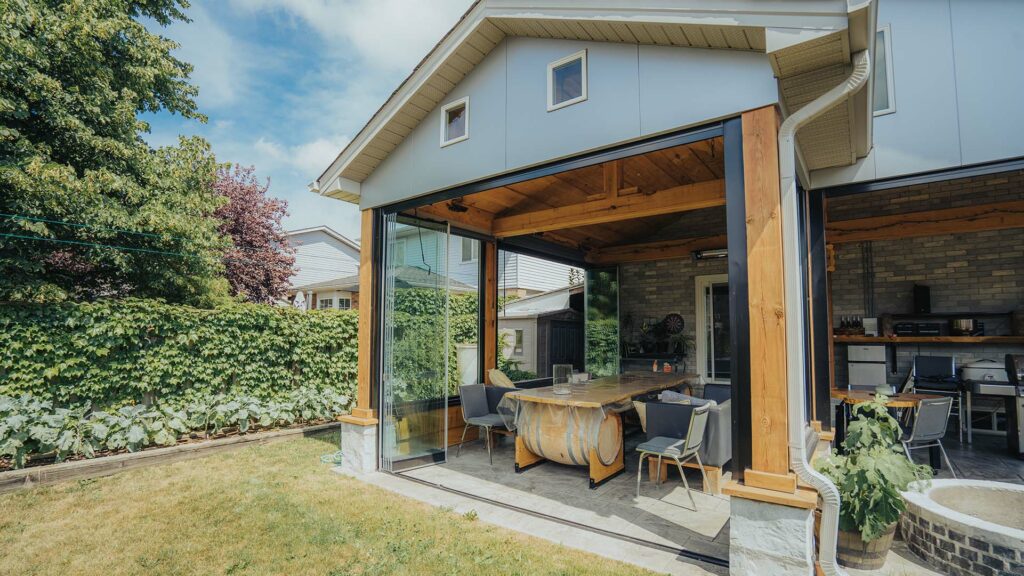
Pier and Beam Foundation
This foundation type elevates the sunroom and uses piers anchored into the ground to provide support.
Pros of Pier and Beam Foundations:
- Flexibility: Easier to repair or modify than a concrete slab.
- Suitable for Slopes: Works for uneven or sloping terrain.
Cons of Pier and Beam Foundations:
- Stability: May require extra support for larger structures.
- Insulation: Less effective at retaining heat compared to concrete options.
Best For:
- Homes with existing surfaces (pavers, interlocking), on which full replacement is not desired by the homeowner.
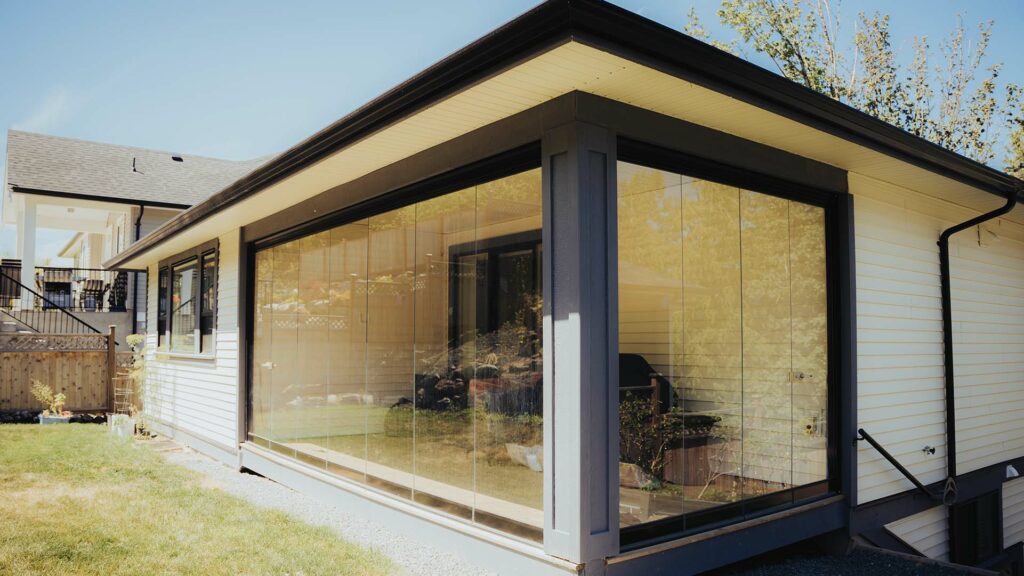
Key Considerations for Choosing a Foundation
Selecting the right foundation involves more than just understanding the pros and cons of each type. Here are some key considerations to keep in mind:
- Budget: Budget is an important factor when deciding on a foundation type. While concrete slabs offer stability, wooden foundations may be more budget-friendly options, depending on the size and structure of your sunroom.
- Installation Process: Consider the time needed for each foundation type, as some, like concrete slabs, may require curing time, while others, like pier foundations or wooden decks, can be installed more quickly.
- Local Building Codes: All foundations must meet OBC standards or local building codes to ensure safety and legality. But before finalizing your decision, consult local building codes and regulations. Certain foundation types may be required or restricted in your area, and failing to comply could lead to costly fines or require modifications.
- Professional Consultation: Engaging a professional contractor or architect can provide valuable insights and recommendations based on your specific situation. They can assess your property, understand your needs, and suggest the most suitable foundation type.
Choosing the right foundation for your 3-season sunroom is a vital step in the construction process. By understanding the different foundation types and considering factors such as climate, budget, and intended use, you can make an informed decision that ensures your sunroom remains a beloved space in your home for years to come.
Remember, while DIY projects can be rewarding, building a sunroom is a significant undertaking that often requires professional expertise. Don’t hesitate to consult Lumon for any 3-season sunroom needs to ensure your sunroom is built safely and to a high standard.
With the right foundation in place, your sunroom will become a cherished extension of your home, offering a bright and inviting space to enjoy throughout the seasons.
You might also be interested in..
-
What Made This Homeowner Say ‘Yes’ to a Major Outdoor Upgrade
Read more…When Adam Chan set out to enhance his outdoor space in Brampton, Ontario, he was looking for more than just a functional glass enclosure. He wanted something beautiful, durable, and thoughtfully designed, too.
-
Do Sunrooms Contribute to the Gross Floor Area (GFA)?
Read more…Installing a sunroom is a popular way to enjoy more of your outdoor surroundings while staying protected from the elements. Whether it’s sipping your morning coffee in a light-filled space or hosting dinner without worrying about sudden weather changes, a sunroom can feel like a natural extension of your home.
-
How Much Does a Sunroom Cost?
Read more…Sunrooms have become a popular addition for homeowners looking to enhance their living space and connect with the outdoors without compromising comfort. However, as delightful as they may be, planning your sunroom involves understanding the factors that influence its cost.
